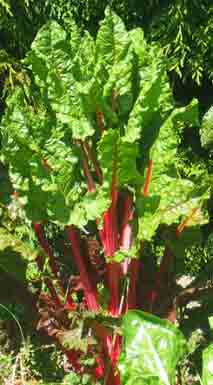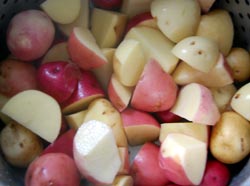Growing Chard and Perpetual Spinach

Growing chard or Swiss chard is very easy and it tends to produce an abundant, tasty crop. This plant offers greens right throughout the winter months. It is a little like spinach but a lot easier to grow.
The method of sowing is similar to beetroot, which is a close family member from the Chenopodiaceae family.
Chard often appears in seed catalogues as Swiss chard, spinach beet, ruby chard and even silverbeet. It is an attractive and striking plant. Some of the red varieties even look worthy of the herbaceous border! The leaves can be a glossy dark green complementing almost fiery red stems.
You can also buy "rainbow" varieties which emerge in a variety of colours from green, through yellows and oranges, to bright red.
Growing chard is well worth the effort because it is so easy and prolific!
This is a tough and vigorous plant which withstands some drought surprisingly well, though it will tend to run to seed if dry weather is prolonged. A good five metre row should provide plenty for an average families needs.
I grew some Rainbow chard last summer and they withstood practically three months without any significant rainfall. They looked a bit sad - but once autumn arrived, they started into quite vigorous growth again.
Growing Swiss chard
Growing chard really is easy. Sow chard, of whatever variety, from spring through to autumn, in well manured ground.
Seed needs to be sown about 2cm (3/4 -1 inch) deep about 10cm between plants.
Thin down the row as the seedlings develop to get plants about 9 or 10 inches apart by maturity.
It is always best to sow chard or other beet family seeds when the soil is damp. If you have to sow in dry conditions water the ground copiously before and after the seeds are sown. Be prepared to irrigate your chard patch or row in really dry weather.
Chard for salad greens
The thinnings can be used in salads or to add to dishes of greens.
The mature plants' leaves are
delicious chopped and sautéed in butter. The stems are especially tasty, having
a salty, subtle favour. They also work very well steamed with new potatoes.
A very easy and
reliable vegetable!
To remove leaves, either use a sharp knife and cut down low without damaging adjacent leaves - or twist each leaf off carefully. If the soil is damp you may need to be careful that you do not uproot the smaller plants - so use a supporting hand to steady the stem when you pull leaves off.
Spinach beet and Swiss
chard seeds will last for a few seasons but collecting seeds from mature plants
is also quite easy. Make sure that they are thoroughly dried and then store them in a cool, dry place. Paper bags are good for storing seeds as they will keep on drying slowly.
Growing perpetual spinach or leaf beet
Growing perpetual spinach or leaf beet is just as easy as growing chard.The plants tend to be smaller and the stems are tougher, though they can grow quite large if you leave them to run to seed.
Make a shallow trough in well-tilled soil and plant seeds thinnly. Water well after covering and firming.
See the page on growing beetroot for more details.
Self-seeded perpetual spinach can do well and can even be transplanted when young, provided that the soil is kept moist. The tap root tends to become long, so do any transplanting as early as possible.
Perpetual spinach which is running to seed can be reinvigorated by simply chopping off the seeding heads. Young seed heads can be used in stir-fries along with leaves.
Fresh green leaves are delicious with new potatoes. Put them in towards the end of cooking for just a few minutes. They are even better steamed.
For a wild and free alternative, try using sea beet leaves. They tend to be fleshier than standard leaf beet and in my book they are better. The coasts of Britain often abound with sea beet. Make sure that you only pick from clean environments and that you are sure of identification.
How to grow a vegetable garden
| Tweet |

| Tweet |

What our readers say...
I've just fallen into your website and wanted to say how great it is!! I've got a lot of cheap ideas and when you're on a tight budget - that's vital! - Gail, NZ
Your site has been an exceptional resource as I have sought to modify my lifestyle. - Art, US
Just a big thank you for all the info! - Estelle, US
Loved your simple, clear approach. Thanks for the many great tips. - Laura, AUS
I found your Web site fascinating... - Steve, US

More related pages:
Footprints
- an occasional e-zine from Greenfootsteps
If you would like to receive the e-zine, please just sign up below.






New! Comments
Have your say about what you just read! Leave me a comment in the box below.